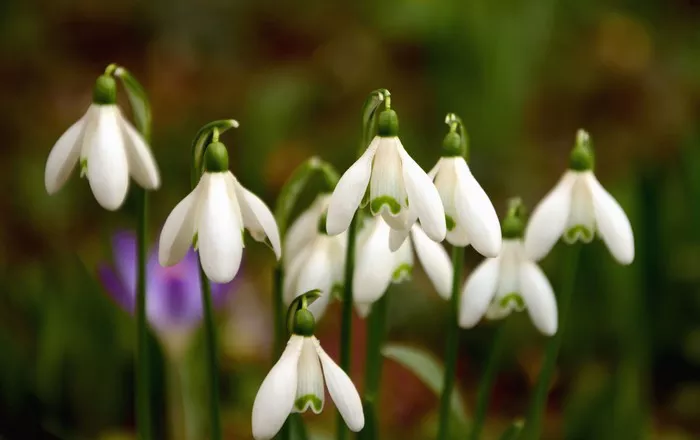Snowdrops, the delicate heralds of spring, bring a sense of renewal and hope as they peek through the frosty ground, signaling the end of winter’s grasp. These petite flowers, scientifically known as Galanthus, belong to the family Amaryllidaceae and are cherished for their understated beauty and resilience. In this comprehensive exploration, we delve into the anatomy, variations, significance, and cultivation of snowdrop flowers, uncovering the secrets of these ethereal blooms.
Anatomy of Snowdrop Flowers
Snowdrop flowers boast a simple yet elegant structure, consisting of several key components that contribute to their charm:
1. Petals: Each snowdrop typically features six tepals, which are petal-like structures that are indistinguishable from each other. These tepals are usually pure white, although some varieties may exhibit hints of green or yellow at their tips.
2. Inflorescence: Snowdrops bloom singly or in small clusters, emerging from slender stems that rise above the plant’s basal leaves. The inflorescence is often drooping, giving the flowers a graceful appearance.
3. Foliage: The basal leaves of snowdrop plants are narrow and elongated, resembling blades of grass. These leaves emerge from the base of the stem and provide a verdant backdrop for the delicate blossoms.
4. Bulbs: Like many bulbous plants, snowdrops grow from underground bulbs, which store nutrients and energy for the plant’s growth and flowering. These bulbs multiply over time, forming dense clumps that enhance the visual impact of snowdrop displays.
Variations in Snowdrop Flowers
While the classic image of a snowdrop features pristine white petals, enthusiasts will delight in the diverse array of cultivars and species that exist within the genus Galanthus. Some notable variations include:
1. Galanthus nivalis: The common snowdrop, native to Europe, is the archetype of its genus, with pure white flowers and a subtle fragrance. It often naturalizes in woodlands and meadows, creating expansive carpets of white in early spring.
2. Galanthus elwesii: This species, native to Turkey, features larger flowers with distinct green markings on the inner segments. Galanthus elwesii is prized by collectors for its robust constitution and striking appearance.
3. Galanthus woronowii: Hailing from the Caucasus region, this species is known for its broad, glaucous leaves and sturdy flower stems. The blooms of Galanthus woronowii exhibit a distinctive honey-like scent, adding another dimension to their allure.
4. Cultivated Hybrids: Breeders and enthusiasts have developed countless hybrid varieties of snowdrops, incorporating traits such as double flowers, unusual markings, and extended flowering periods. These hybrids offer endless possibilities for gardeners seeking to expand their snowdrop collections.
Significance of Snowdrop Flowers
Beyond their aesthetic appeal, snowdrop flowers hold cultural, symbolic, and ecological significance:
1. Symbol of Hope: Snowdrops are often regarded as symbols of hope and resilience, heralding the arrival of spring after the long, cold months of winter. Their ability to thrive in adverse conditions serves as a reminder of nature’s capacity for renewal and rejuvenation.
2. Cultural Traditions: In some cultures, snowdrops are associated with purity, innocence, and new beginnings. They feature prominently in folklore and literature, where they symbolize themes of perseverance and transformation.
3. Early Pollinators: Snowdrop flowers provide an important food source for early-emerging pollinators such as bees and flies. Their nectar-rich blooms offer sustenance to these insects when few other flowers are available, contributing to the ecological balance of early spring ecosystems.
4. Gardening Heritage: Snowdrops have captivated gardeners for centuries, inspiring dedicated enthusiasts known as “galanthophiles.” These individuals pursue rare and unusual snowdrop cultivars with fervent passion, contributing to a rich horticultural heritage centered around these beloved blooms.
Cultivating Snowdrop Flowers
For those inspired to cultivate snowdrops in their own gardens, here are some essential tips for success:
1. Site Selection: Choose a location with well-drained soil and partial to full shade, mimicking the woodland environments where snowdrops naturally thrive. Avoid areas prone to waterlogging, as excessive moisture can cause bulbs to rot.
2. Planting Depth: Plant snowdrop bulbs at a depth of 2-3 inches (5-8 cm), spacing them 3-4 inches (7-10 cm) apart. Planting in clumps or drifts will create a more naturalistic effect and enhance the visual impact of the flowers.
3. Maintenance: Once established, snowdrops require minimal maintenance. Keep the soil consistently moist during the growing season, but allow it to dry out slightly between waterings to prevent bulb rot. After flowering, allow the foliage to die back naturally to replenish the bulbs’ energy reserves.
4. Propagation: Snowdrops readily naturalize and multiply over time, forming dense colonies in suitable conditions. Lift and divide congested clumps every few years after the foliage has died back, replanting the bulbs at the same depth to encourage continued vigor and flowering.
5. Pest and Disease Management: Snowdrops are generally resistant to pests and diseases, but they may occasionally suffer from issues such as bulb rot, slugs, or aphids. Monitor plants regularly and take appropriate measures to address any problems that arise, such as improving drainage or applying organic pest controls.
Conclusion
In conclusion, snowdrop flowers captivate the hearts of gardeners and nature enthusiasts alike with their delicate beauty, rich symbolism, and early arrival heralding the onset of spring. By understanding their anatomy, exploring their diverse variations, appreciating their significance, and mastering their cultivation, we can fully appreciate the enchantment of these cherished blooms and welcome the promise of renewal they bring each year.


